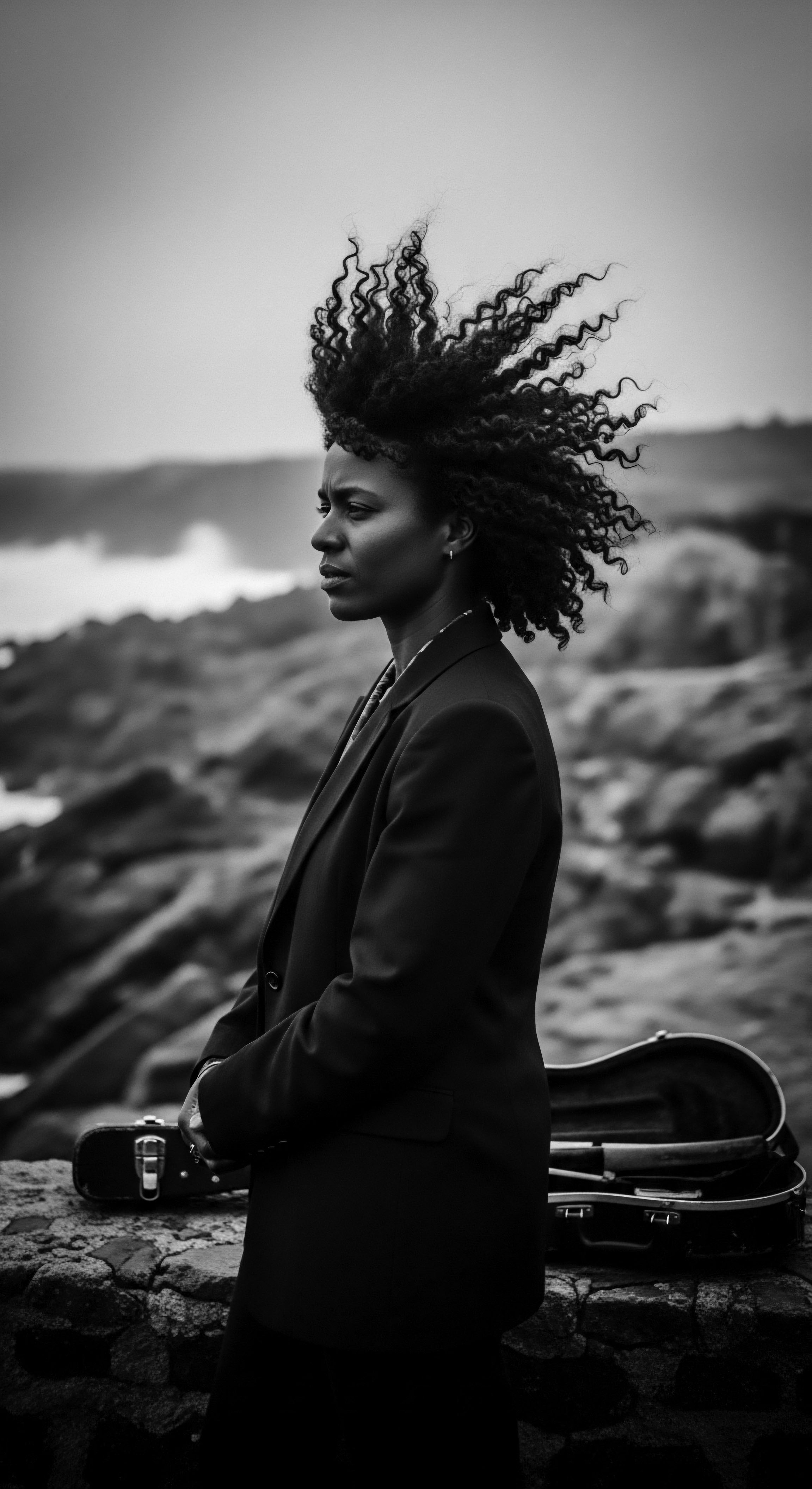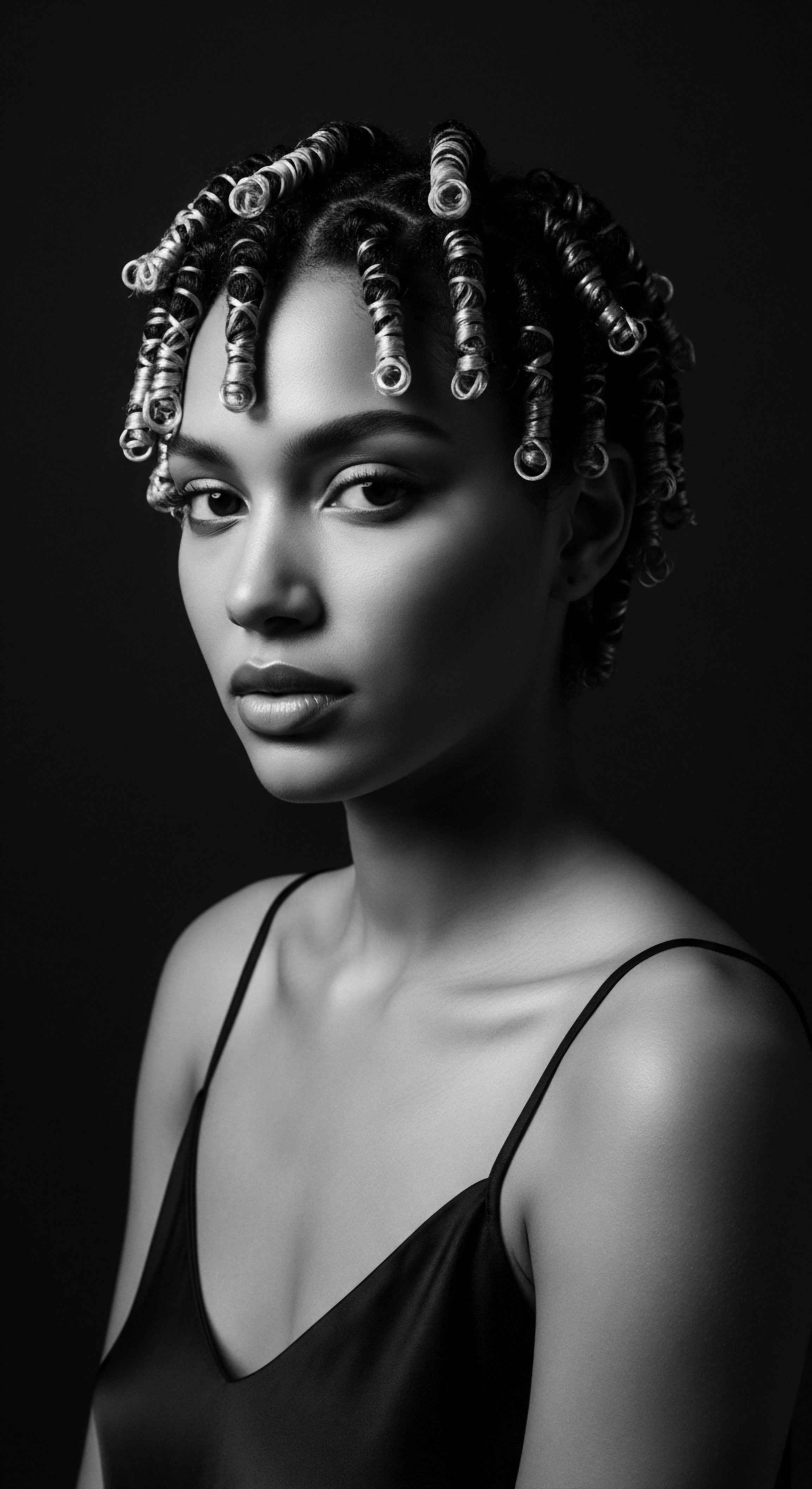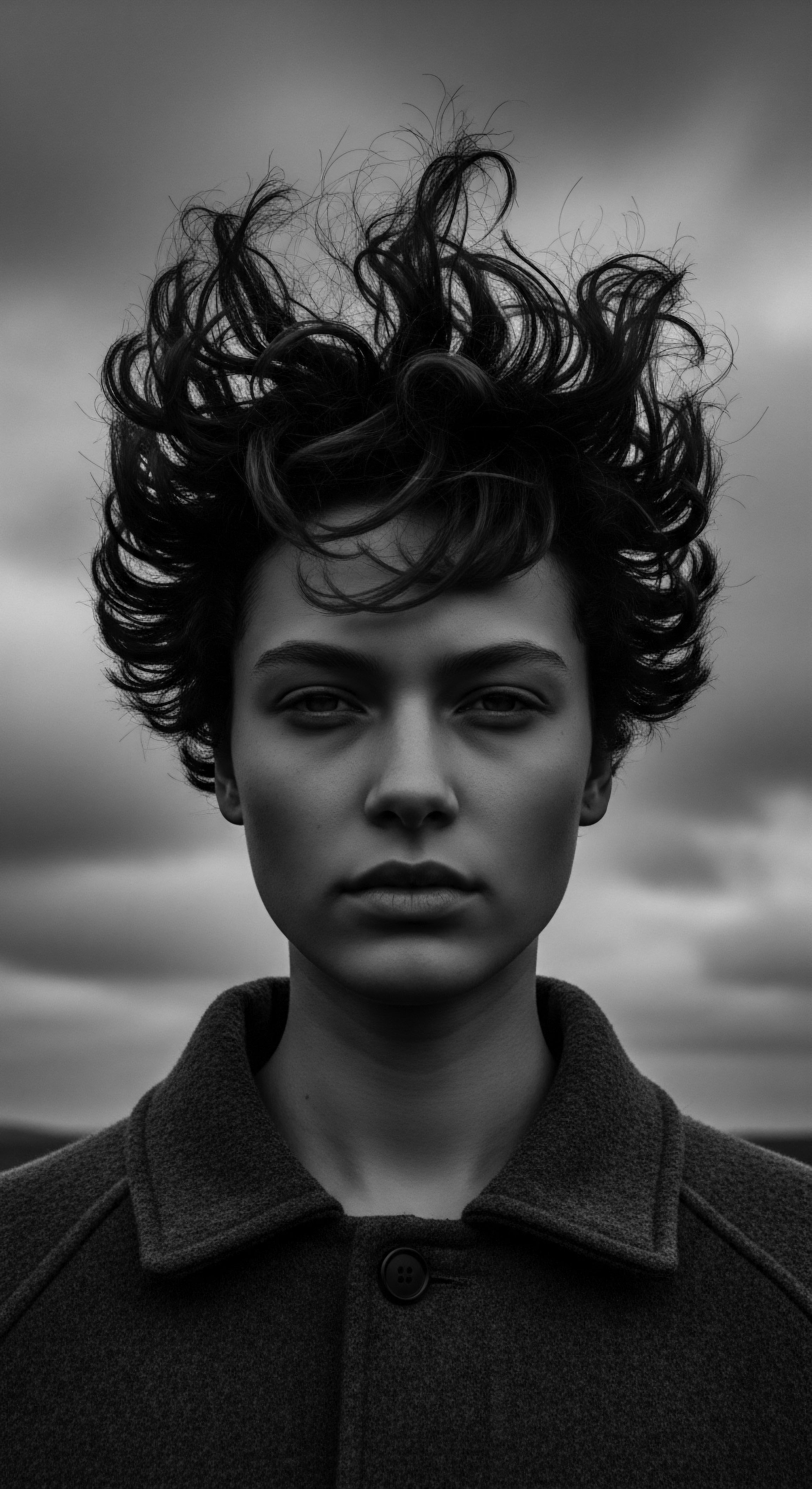
Roots
To journey into the role of melanin in safeguarding textured hair from airborne toxins, we must first recognize the deep, enduring story woven into each strand. This is not merely a biological inquiry; it is an exploration of heritage, of resilience etched into our very being. Imagine the ancient winds, carrying dust and whispers, across landscapes where our ancestors walked.
Their hair, a crown of coils and curls, stood as a sentinel, not simply for adornment, but for elemental protection. Understanding this protection begins with melanin, the very pigment responsible for the vast spectrum of color that graces textured hair.

What is Melanin’s Role in Hair Structure?
Melanin, a natural biopolymer, holds a foundational place in the architecture of hair, particularly within textured types. It is synthesized by specialized cells known as melanocytes, residing within the hair follicles. These industrious cells produce two primary forms ❉ Eumelanin, responsible for the deep browns and rich blacks, and Pheomelanin, lending warmer tones, from reds to yellows. The precise balance and distribution of these pigments determine hair color, certainly, but their influence extends far beyond mere visual appeal.
In textured hair, these melanin granules are not just scattered color; they are intricately embedded within the hair shaft’s cortex, sometimes even influencing the hair’s structural integrity. This placement, this elemental presence, hints at a deeper, protective calling, a biological inheritance that speaks to centuries of adaptation.
The varying concentrations of eumelanin and pheomelanin contribute to the hair’s inherent characteristics. Eumelanin, being denser, generally provides greater structural stability and often confers a deeper, more robust hue. Pheomelanin, with its lighter pigmentation, can sometimes be more susceptible to environmental shifts.
This intricate interplay between melanin types within the hair strand itself contributes to the distinctive visual and tactile qualities that are hallmarks of textured hair. It reminds us that every aspect of hair’s composition, down to its very color, carries a purpose, a quiet declaration of its ancestral journey.
Melanin, the pigment of textured hair, shapes its color and serves as a primal guardian, echoing ancestral adaptations to the environment.

How Do Hair Growth Cycles Connect to Melanin’s Presence?
The continuous cycle of hair growth—anagen (growth), catagen (transition), and telogen (rest)—is profoundly linked to melanin production. Melanocytes are most active during the anagen phase, diligently depositing pigment into the forming hair shaft. As the hair follicle progresses through its cycle, melanin production slows and eventually ceases. This rhythmic process speaks to the hair’s enduring vitality and its intricate biological choreography.
For our ancestors, this consistent renewal, infused with melanin, meant a sustained biological defense. The hair, ever-renewing, constantly replenished its protective shield, a testament to the body’s innate wisdom.
Consider the impact of environmental factors on these cycles. Historical narratives often speak to periods of scarcity or exposure to harsh elements. While these stressors could certainly impact overall hair health, the foundational process of melanogenesis persisted, providing a continuous, albeit sometimes challenged, stream of pigmented, potentially protective, hair. This biological consistency, passed down through generations, highlights the inherent durability encoded within textured hair.

Ritual
From the very architecture of a strand, we move to the living traditions that have shaped the care of textured hair for millennia. The question of melanin’s role in protection extends beyond pure biology; it resides within the mindful rituals and styling practices passed down through ancestral lines. These practices were not random acts of beauty; they were often profound responses to the environment, embodying a deep, intuitive understanding of hair’s needs, an understanding that perhaps implicitly recognized melanin’s inherent strengths.

What Ancestral Styling Practices Offer Protection?
Long before the scientific lens dissected hair’s chemistry, communities across the African diaspora cultivated sophisticated hair care traditions. Braids, twists, cornrows, and various forms of wrapping were more than aesthetics; they served as a protective shield against the sun, dust, and other elements encountered during daily life and labor. These styles, often communal activities, fostered connection and shared wisdom, transmitting knowledge about what kept hair healthy in specific environments. While the exact scientific mechanism was not articulated, the experiential knowledge of reducing exposure to airborne particulate matter and direct sunlight was deeply embedded within these practices.
For instance, in many West African cultures, intricate braiding patterns denoted social status, age, or tribal identity, but also served a practical purpose of securing the hair and minimizing its exposure. These practices created a kind of natural armor for the hair, reducing friction and environmental wear.
| Historical Practice Braiding and Cornrowing |
| Contemporary Relevance and Melanin Connection Reduces hair strand exposure to airborne irritants. Melanin within the hair shaft continues its internal protective action while physical barriers lessen external stress, preserving the hair's natural integrity. |
| Historical Practice Hair Wrapping and Head Coverings |
| Contemporary Relevance and Melanin Connection Physical barrier against dust, pollutants, and sun. This practice, rich with cultural meaning, directly lessens the external burden on hair, allowing melanin's intrinsic photoprotective qualities to remain uncompromised. |
| Historical Practice Oiling and Butter Application |
| Contemporary Relevance and Melanin Connection Seals the cuticle, potentially preventing toxin adherence and supporting melanin's antioxidant work. Many traditional oils, like shea butter, contain compounds that offer additional environmental protection. |
| Historical Practice Ancestral styling practices, deeply woven into heritage, provided practical defense against environmental elements, indirectly supporting melanin's innate protective functions. |
The application of natural oils and butters, such as Shea Butter or Black Seed Oil, was another common practice. These rich emollients created a physical barrier on the hair shaft, helping to seal the cuticle. This action would likely reduce the direct adherence of airborne particles and potentially lessen the penetration of harmful substances. One might consider these ancestral preparations as an early form of environmental conditioning, working in concert with the hair’s natural defenses, melanin included.
Styling choices, passed through generations, built a protective heritage around textured hair, intuitively recognizing needs fulfilled by both physical barriers and internal resilience.

How Do Traditional Tools Reflect Hair Health Needs?
The tools used in ancestral hair care, often carved from wood or bone, were designed to navigate the unique contours of textured hair with respect and care. Wide-toothed combs, for instance, minimized breakage, preserving the hair’s structural integrity. This physical preservation meant fewer compromised areas where airborne aggressors might gain entry. The communal act of grooming with these tools reinforced a collective understanding of healthy hair as a symbol of vitality and communal identity.
This approach highlights a mindful interaction with the hair, treating it as a living entity deserving of gentle attention. Such care, steeped in ancestral wisdom, invariably supported the overall health of the hair, allowing its inherent protective elements, like melanin, to function optimally. The deliberate gentleness ensured the hair’s cuticle remained as intact as possible, a crucial line of defense against the outside world.
Consider the Himba Tribe of Namibia, whose women traditionally coat their hair in an ‘otjize’ paste of ochre, butterfat, and aromatic resins. This practice, while aesthetically striking, also acts as a profound protective layer against the harsh sun and arid desert dust. This historical example illustrates how deeply intertwined cultural practices are with practical environmental defense, extending the hair’s natural capabilities.

Relay
The knowledge gleaned from ancestral wisdom and intuitive care now finds its deeper resonance within the language of science. The enduring presence of melanin in textured hair speaks to its biological significance, particularly when faced with the myriad of airborne toxins that mark our modern existence. Here, the threads of ancient practice and contemporary understanding truly intertwine, revealing melanin’s active role in maintaining hair’s integrity amidst environmental challenge.

What Scientific Functions Does Melanin Provide Against Toxins?
Melanin’s contribution to hair health transcends its role as a mere coloring agent. It is a complex biopolymer known for its remarkable capabilities, particularly in the realm of environmental protection. These properties offer a compelling biological counterpoint to the oxidative stress and damage induced by airborne pollutants.
- Antioxidant Activity ❉ Melanin possesses the ability to neutralize free radicals, which are unstable molecules generated by pollution, UV radiation, and other environmental stressors. These free radicals can damage hair proteins and lipids, leading to weakened strands and compromised health. Melanin acts as a natural scavenger, quenching these reactive species and mitigating their destructive potential. This inherent antioxidant capacity provides a continuous, internal shield for the hair fibers.
- Metal Chelating Property ❉ A profound aspect of melanin’s protective function involves its capacity to bind to heavy metal ions. Airborne toxins often include trace heavy metals, such as copper, lead, and cadmium, which can accumulate on hair surfaces and even penetrate the shaft. Once inside, these metals can catalyze further free radical formation, intensifying oxidative damage. Melanin’s unique chemical structure, particularly its carboxyl (-COOH), amine (-NH), and hydroxyl (-OH) groups, allows it to form stable complexes with these metal ions, effectively sequestering them and preventing their harmful interactions with hair proteins. This mechanism is crucial in mitigating the damaging effects of metal contamination from the atmosphere.
Melanin’s inherent properties, particularly its antioxidant and metal-binding abilities, provide textured hair with a biological shield against environmental pollution.
A pivotal study by Zou, Shi, and Wang (2011) highlights melanin’s potential as a biological agent for environmental applications, specifically mentioning its capacity for heavy metal remediation. This research supports the understanding that melanin in hair, like its counterparts in other biological systems, possesses inherent properties to interact with and potentially neutralize environmental threats. The concept of melanin acting as a “radical sink” and an ion exchanger that binds toxins speaks directly to its active participation in protecting textured hair from airborne contaminants.

How Do Environmental Factors Impact Melanin in Hair?
The hair’s journey through various environments exposes it to a host of airborne aggressors. Particulate matter, industrial emissions, vehicle exhaust, and even the ozone can contribute to a burden on hair. While melanin provides a degree of protection, prolonged or intense exposure can challenge its capacity. Oxidative stress can lead to melanin degradation, sometimes resulting in changes to hair color or a diminished protective capacity over time.
Understanding this dynamic is crucial for appreciating the ancestral wisdom embedded in protective styling and meticulous care. These practices, while not framed in terms of “oxidative stress” or “metal chelation,” intuitively countered the external pressures that could overwhelm hair’s natural defenses. The protective styling, for example, lessens the direct physical deposition of particulate matter, reducing the initial burden on melanin to act.
The resilience of textured hair, often steeped in higher concentrations of eumelanin, perhaps reflects a deeper evolutionary adaptation to environmental challenges encountered across ancestral lands. This inherent biological endowment, combined with cultural practices, speaks to a holistic approach to hair preservation that predates modern science but finds validation in its insights.

Reflection
The journey through melanin’s quiet yet formidable role in safeguarding textured hair from airborne toxins offers more than scientific insights; it unveils a profound narrative of heritage and enduring wisdom. Each coil, each curve, carries within it the echoes of ancestral resilience, a biological endowment shaped by generations living in intimate connection with their surroundings. The hair on our heads stands as a living archive, silently recounting tales of adaptation, ingenuity, and a deep, intrinsic beauty that has survived countless environmental shifts.
The strength of textured hair, often attributed to its unique structure, is undoubtedly augmented by the very melanin that gives it color. This pigment, a silent guardian, has offered a continuous shield against the invisible threats carried by the air—from the dust of ancient plains to the complex pollutants of modern cities. It reminds us that protection is not always an external application; sometimes, it is an innate, inherited power, a whisper from the past that continues to serve the present.
Roothea’s ethos calls us to honor this legacy, to approach textured hair not merely as a canvas for styling, but as a sacred extension of self and heritage. Understanding melanin’s protective capacities deepens our respect for the ancestral practices that intuitively supported hair health. These rituals—the careful braiding, the nourishing oils, the communal grooming—were, in essence, early forms of environmental care, a testament to a wisdom that instinctively understood the interplay between body, earth, and spirit.
As we move forward, armed with both ancestral knowledge and contemporary science, we are called to embrace this intertwined understanding. The unbound helix of textured hair, free and vibrant, continues to tell its story. It speaks of a biological fortitude, a cultural richness, and an ongoing dialogue between past wisdom and future possibility. The melanin within each strand stands as a quiet, powerful symbol of this enduring connection, a constant reminder of the profound soul held within every hair.

References
- Zou, N. Shi, H. & Wang, H. (2011). Melanin as a biological agent for environmental applications ❉ a review. International Journal of Environmental Science and Technology, 8(1), 183-196.
- Millington, K. R. & Marsh, J. M. (2020). UV damage to hair and the effect of antioxidants and metal chelators. International Journal of Cosmetic Science, 42(2), 174-184.
- Manirethan, M. et al. (2018). Melanin nano-pigments for heavy metal remediation from water. ResearchGate.
- St. Surin-Lord, S. (2020). Sun, Metals & Pollution Are Damaging Your Hair. Happi.
- Sajjan, M. Thaira, T. & Manirethan, M. (2019). Natural Melanin ❉ Current Trends, and Future Approaches, with Especial Reference to Microbial Source. MDPI.
- Milington, K.R. & Marsh, J.M. (2020). UV Damage to Hair and The Effect of Antioxidants and Metal Chelators. International Journal of Cosmetic Science.
- Zainal Mustakim, Z. et al. (2024). Review on Melanin Application as an Antibacterial and Antioxidant Agent in Food Packaging. Indonesian Journal of Chemistry, 24(6), 1906-1920.
- Sajid, M. & Akbar, S. (2018). Pigments ❉ Classification, Sources and Applications. Pigment Science, 1(1), 1-10.
- Gonzales, A. & Williams, A. (2025). Ancestral Hair Rituals to Nourish Your Hair and Soul. Substack.
- Anon. (2024). Best ways to restore melanin to hair. Lafeminite Organic Moroccan Skincare Products.
